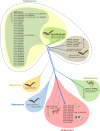Coronavirus Disease 2019-COVID-19
- PMID: 32580969
- PMCID: PMC7405836
- DOI: 10.1128/CMR.00028-20
Coronavirus Disease 2019-COVID-19
Abstract
SUMMARYIn recent decades, several new diseases have emerged in different geographical areas, with pathogens including Ebola virus, Zika virus, Nipah virus, and coronaviruses (CoVs). Recently, a new type of viral infection emerged in Wuhan City, China, and initial genomic sequencing data of this virus do not match with previously sequenced CoVs, suggesting a novel CoV strain (2019-nCoV), which has now been termed severe acute respiratory syndrome CoV-2 (SARS-CoV-2). Although coronavirus disease 2019 (COVID-19) is suspected to originate from an animal host (zoonotic origin) followed by human-to-human transmission, the possibility of other routes should not be ruled out. Compared to diseases caused by previously known human CoVs, COVID-19 shows less severe pathogenesis but higher transmission competence, as is evident from the continuously increasing number of confirmed cases globally. Compared to other emerging viruses, such as Ebola virus, avian H7N9, SARS-CoV, and Middle East respiratory syndrome coronavirus (MERS-CoV), SARS-CoV-2 has shown relatively low pathogenicity and moderate transmissibility. Codon usage studies suggest that this novel virus has been transferred from an animal source, such as bats. Early diagnosis by real-time PCR and next-generation sequencing has facilitated the identification of the pathogen at an early stage. Since no antiviral drug or vaccine exists to treat or prevent SARS-CoV-2, potential therapeutic strategies that are currently being evaluated predominantly stem from previous experience with treating SARS-CoV, MERS-CoV, and other emerging viral diseases. In this review, we address epidemiological, diagnostic, clinical, and therapeutic aspects, including perspectives of vaccines and preventive measures that have already been globally recommended to counter this pandemic virus.
Keywords: COVID-19; One Health; SARS-CoV-2; diagnosis; emerging coronavirus; therapy; vaccines.
Copyright © 2020 American Society for Microbiology.
Figures







References
-
- Rodriguez-Morales AJ, Bonilla-Aldana DK, Balbin-Ramon GJ, Rabaan AA, Sah R, Paniz-Mondolfi A, Pagliano P, Esposito S. 2020. History is repeating itself: probable zoonotic spillover as the cause of the 2019 novel coronavirus epidemic. Infez Med 28:3–5. - PubMed
-
- Zhu N, Zhang D, Wang W, Li X, Yang B, Song J, Zhao X, Huang B, Shi W, Lu R, Niu P, Zhan F, Ma X, Wang D, Xu W, Wu G, Gao GF, Tan W, China Novel Coronavirus Investigating and Research Team . 2020. A novel coronavirus from patients with pneumonia in China, 2019. N Engl J Med 382:727–733. doi:10.1056/NEJMoa2001017. - DOI - PMC - PubMed
Publication types
MeSH terms
LinkOut - more resources
Full Text Sources
Other Literature Sources
Miscellaneous

